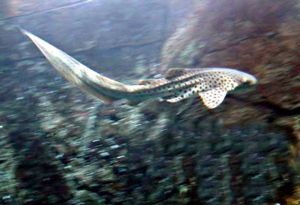Zebra shark
2008/9 Schools Wikipedia Selection. Related subjects: Insects, Reptiles and Fish
| Zebra shark | ||||||||||||||||
|---|---|---|---|---|---|---|---|---|---|---|---|---|---|---|---|---|
 |
||||||||||||||||
| Conservation status | ||||||||||||||||
|
Vulnerable
|
||||||||||||||||
| Scientific classification | ||||||||||||||||
|
||||||||||||||||
| Binomial name | ||||||||||||||||
| Stegostoma fasciatum ( Hermann, 1783) |
||||||||||||||||
 Range of zebra shark (in blue)
|
The zebra shark, Stegostoma fasciatum, is a common carpet shark of inshore Indo-Pacific waters notable for its very long caudal fin, nearly as long as its body. It is the only species in the family Stegostomatidae and the genus Stegostoma.
Common name
The name zebra shark is given because as a juvenile the shark has zebra-like stripes. When it matures these stripes change to cheetah-like spots. Because of this change in its coloration, it may also be sometimes known as the leopard shark, a name widely used to refer to Triakis semifasciata, a small benthic shark found in the Eastern Pacific coastline of North America.
Distribution and habitat
The zebra shark is found in the tropical Western Pacific and Indian oceans at depths of about 5 to 30 m.
Anatomy and appearance
It is a very sleek and slender shark, about 3.5m (11.5 ft) long. In addition to the long tail, the zebra shark has distinctive ridges running down its body. As its names suggest, it is patterned; young sharks are dark with yellowish stripes, changing to an adult pattern of a tan colour with dark spots, found all over including the fins. The snout is rather rounded, with small barbels (whiskers).
Behaviour
The zebra shark is a slow-moving type, often just sitting on the seafloor in the vicinity of coral reefs, on sandy or rocky bottoms. Unlike most types of sharks, it does not need to move, and instead pumps water through its gills. This is known as the ram-jet effect.
Diet
It feeds on mollusks, crustaceans, and small fish that it sucks out of the sand at night, and is capable of wiggling through small holes and crevices in its search for food.
Importance to humans
Zebra sharks do well in captivity, and a number of aquariums around the world have them on display. They are fished commercially on a small scale. They are often seen by scuba divers, and will lay still on the bottom as long as a diver does not come too close. They are harmless to divers as long as they are not disturbed. In addition several aquariums have shown them to be easy learners, even teaching them to respond to touch by flapping their gills. Due to its large caudal fins, this species are a prized catch for fishermen to make shark fin soup.
In popular culture
The male lead of Margaret Drabble's The Sea Lady is an expert on zebra sharks, which plays a substantial part in the plot.
